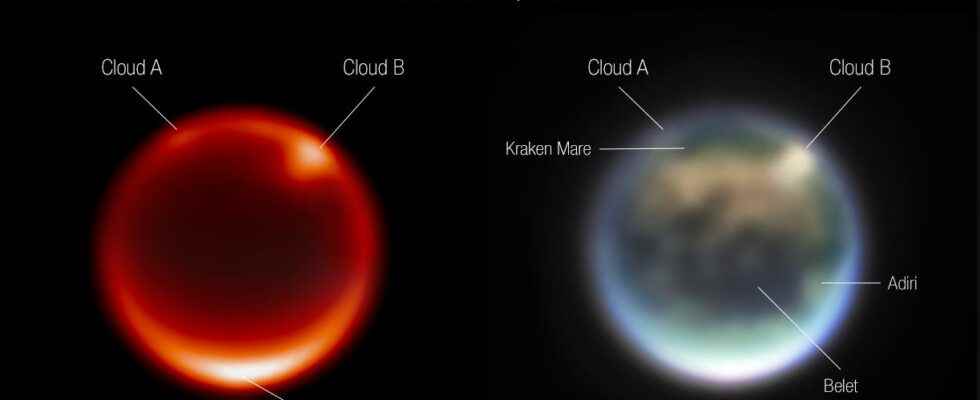For its first images of the moon Titan, the James Webb infrared telescope detects… clouds there! This unusual event led a team of astronomers to confirm the results with the Keck Ground Telescope in Hawaii. The images and data recovered will be of interest for future missions.
Notably for Dragonfly, which will consist of a large multicopter planned for 2027.
Through the atmosphere to see clouds
The surface of Titan is barely visible, and for the human eye, it is not at all: it is the only moon in our Solar System to be surrounded by a very thick atmosphere, mainly composed of methane and CO2. But this “hydrocarbon paradise” has already been visited, in particular during the Cassini mission. However, to see through clouds, you either need radar or use a frequency band that does not show them, such as infrared.
And that’s good enough, since humanity has had a brand new space telescope with extraordinary infrared sensors since this summer! The James Webb Telescope took its first photographs of Titan on Nov. 4, and the initial results (once again) exceeded the hopes of astrophysicists who requested them. Not only were the main features of Titan’s surface visible, but the team immediately identified what appeared to be… a cloud!
Slice of Keck
Clouds are relatively rare in Titan’s atmosphere, although the phenomenon has been observed before, especially during long-duration campaigns. They only appear near the equator and in the Northern Hemisphere, in late summer, when the Sun warms the area.
After the detection of a second cloud, the team analyzing the data (including Sébastien Rodriguez, researcher at the University of Paris Cité) turned to the specialists of the titanic clouds… in Hawaii. Indeed, the Keck telescope has an instrument called NIRC2, commissioned in 2015, which operates in near infrared. To prevent it from being disturbed by the Earth’s atmosphere, it involves optical deformations generated on its mirror (adaptive optics), which allows excellent resolution, very close to what the JWST had just obtained.
The evening following receipt of the pictures from the James Webb, the teams were able to obtain an observation slot (again, this is relatively rare) in Hawaii. And in the hours that followed, the Keck confirmed the sighting of clouds on Titan.
The JWST still does not disappoint
With these two parallel observations, there are many prospects for the study of Titan. First, its atmosphere will be better understood thanks to the instruments of the JWST. For information, NIRCam, which produced the most “beautiful” image, is not the only one to have taken pictures, there are also the other spectra.
Then, this is a new opportunity to observe and understand the clouds of Titan, which allow validating atmospheric models of Saturn’s moon. This task is more important than it seems, especially for NASA, which plans to send an 8-rotor flying robot to the site in less than a decade (take-off in 2027).
Finally, double observations of the kind make it possible to refine the data and better calibrate future measurements, whether on the ground or in space. And then, for us, it is (unsurprisingly) very pretty.
Source : NASA

8